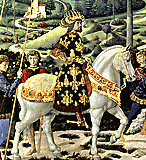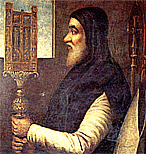 |
|
 |
The Balkans. Union of Ferrara and Florence
 hile Byzantium was extending its rule over the Peloponnese,
hile Byzantium was extending its rule over the Peloponnese,
 further north Thessalonike was fighting its last battle against the Turks. The latter, after a short but cruel siege, became masters of the city on 29 March 1430 and took captive all the civilians who had escaped slaughter. After Thessalonike, the Turks beseiged Ioannina. The inhabitants of Ioannina, however, shattered by the disaster of Thessalonike, chose to accept the privileges promised them by the Turks on condition that they offer no resistance, and surrendered the city to them in October 1430. further north Thessalonike was fighting its last battle against the Turks. The latter, after a short but cruel siege, became masters of the city on 29 March 1430 and took captive all the civilians who had escaped slaughter. After Thessalonike, the Turks beseiged Ioannina. The inhabitants of Ioannina, however, shattered by the disaster of Thessalonike, chose to accept the privileges promised them by the Turks on condition that they offer no resistance, and surrendered the city to them in October 1430.
The new losses forced the Emperor to turn once again to the West and the Pope for help. In 1431, he thus began a new cycle of contacts with the Pope and the Western sovereigns
 who, during a council in the same year, had posed the issue of important decisions being taken by councils and not by the Pope. The dispute between Pope
Eugenius IV
and the Western rulers delayed the negotiations, but it was finally decided to convene a council at Ferrara, which, among other issues, would resolve that of the union of the Churches. The council would be attended by John VIII himself, who would journey to the West not only to seek assistance but also to realise union with Rome. Before leaving, in November 1437, he who, during a council in the same year, had posed the issue of important decisions being taken by councils and not by the Pope. The dispute between Pope
Eugenius IV
and the Western rulers delayed the negotiations, but it was finally decided to convene a council at Ferrara, which, among other issues, would resolve that of the union of the Churches. The council would be attended by John VIII himself, who would journey to the West not only to seek assistance but also to realise union with Rome. Before leaving, in November 1437, he
 appointed his brother
Constantine
regent in his absence. appointed his brother
Constantine
regent in his absence.
The Byzantine delegation, consisting of 30 bishops and a number of laymen, reached Ferrara at the beginning of March and on 9 April 1438 the council began its discussions, which lasted throughout the entire year. In 1439, financial problems and an epidemic that had broken out in Ferrara obliged the council to move to Florence, where the union of the Churches was finally signed. The text of the agreement was formally read in the Cathedral of Florence, in Latin by Cardinal
Cesarini,
and in Greek by the Archbishop of Nicaea,
Bessarion.
|